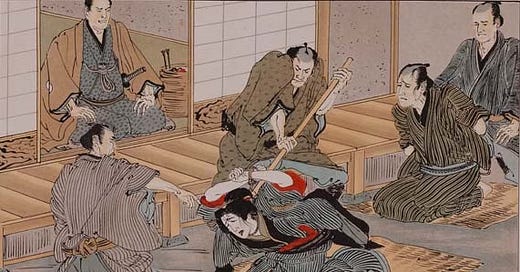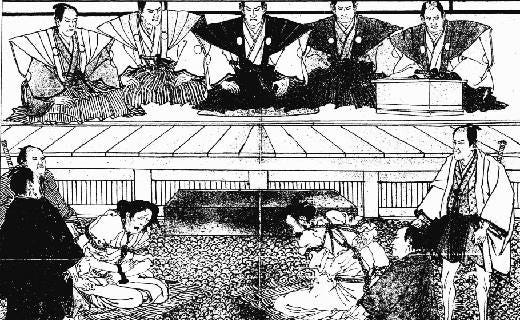Yoriki (与力) was an occupational position dating from the Kamakura period (1185–1333) and a title particularly recognised within the Edo Shogunate. It can also be written as Yoriki, (寄騎)but the meanings of each differed slightly depending on the era.
In the Kamakura period, yoriki simply referred to people who provided direct assistance to their lords, but in later years the title came to refer more regularly to lower-ranking samurai who served a daimyo or powerful general. During the Sengoku period, Yoriki were often lower-ranking samurai feudal lords, and it was not uncommon for them to own substantial tracts of land. The term was also later used to refer to mid-ranking samurai such as ashigaru taisho (captain of an ashigaru unit) under the command of a higher-ranking samurai.
Often military commanders who were attached to larger daimyo as reinforcements were known as yoriki daimyo, literally, group subordinate daimyo. For example, within the military formation of Oda Nobunaga’s forces, elite warriors such as Kawajiri Hidetaka and Mori Nagayoshi were attached to Oda Nobutada, Maeda Toshiie and Sassa Narimasa who served in turn as support under Shibata Katsuie, while Hosokawa Fujitaka and Tsutsui Junkei were attached to Akechi Mitsuhide. (incidentally, The Akechi, Hosokawa, and Tsutsui were close relatives and friends.) In such cases, the yoriki daimyo received instructions only from the daimyo commanding the corps when conducting unified military operations, and with the exception of Oda Nobutada (eldest son and heir of Nobunaga) the Oda generals were all of equal status.
Yoriki of the Edo Shogunate - To Serve and To Protect
Edo was the world’s largest city, and even during the peaceful Edo period, there were those who disobeyed the rules of society. Crimes were committed just as they are today. Theft, robbery, attacks, disputes, bribery and cover-ups were very much part of the otherwise orderly and systematic Edo period Japan. It was the yoriki of Edo the who protected this peace.
Along with the Edo magistrates, the yoriki and doshin are often the main characters in period dramas and movies, akin to the cop and detective series seen on western TV.
Doshin were one of the lower-ranking officials of the Edo Shogunate. They served under the magistrates, Kyoto governors, castle lords, head clerks, the Arson and Theft Control Bureau, and oversaw general affairs and security running patrols under the Yoriki. Their rank was that of foot soldiers, but without samurai rank.
Yoriki of the Edo Shogunate were initially assigned to assist their superiors, in this case usually Hatamoto ranked samurai. Many of these Yoriki were of Gokenin status, they were allowed to wear hakama and ride horses.
The most famous of the Yoriki, celebrated in many modern period novels, TV dramas and movies, were the Machikata Yoriki who assisted and served under the Edo Machi-bugyo — town magistrates — and were responsible for administrative, judicial, and police duties in the city of Edo. There were 25 yoriki and 100 doshin stationed in each of each of Minami-machi and Kita-machi bugyosho offices. (In 1745, the number of doshin was increased by 20 each).
There were basically two types of yoriki: Regular yoriki and the Uchi Yoriki, who were retainers and received a stipend from the machi-bugyo himself. These men had originally been trusted staff or servants of the magistrate before taking up their post, and would arrive and leave the magistrate's office with their lord.
Regular Yoriki were officials receiving a stipend directly from the shogun and were attached to the magistrate's office. As uchii-yoriki were subordinate vassals, they were essentially of a lower rank than other yoriki and generally received lower stipends, but as close aides to the magistrate, they wielded very real power. Yoriki managed, commanded and supervised the doshin under them, and in terms of police power, they were the equivalent of modern-day police chiefs, although without jurisdiction over territories. They oversaw investigating both civil and criminal cases, in effect, playing the added role of judge and prosecutor.
The yoriki were provided with an official residence of about 300 tsubo (10,000 m2) and were grouped in Edo’s Hatchobori area as their official residence. The stipend of a yoriki was on average 150 to 200 koku. A doshinreceived 30 koku alone for the hiring of two staff. They also received extra income in the form of the many gifts from various feudal lords and townspeople they had assisted in the event of disputes. Unlike other shogunate officials, the yoriki and doshin, who numbered nearly 300 in total, were in fact a hereditary position.
Yet another perk of their position was that they could take a morning bath in the women's bath at the public bathhouse. This was because the bathhouses in Hatchobori were particularly crowded, and because women at the time rarely had a morning bath, and so it was usually empty, making it an ideal place to eavesdrop on rumors and secret conversations that were taking place in the adjoining men's bath. In fact, a sword rack was placed in the women's bath just for the yoriki. The yoriki would have their unique topknot styled by a hairdresser who came to the group residences before starting their shifts. As such, the unique topknots of yoriki, sumo wrestlers, and firemen in particular were admired by many.
The machi-yoriki-kumicho class received a stipend of over 200 koku, which was better than that of many lower-ranking hatamoto. However, because they dealt with criminals, they were considered unclean officials and as such were not permitted audiences with the shogun or even allowed enter Edo Castle. Therefore, their status was that of vassals of the Gokenin, and among them, they received a higher salary.
Because they were treated as kishi rank, or cavalry, the Yoriki were expected to wear hakama, but they did not have the right to onarisaki gomen, a privilege granted to doshin, who were treated as infantry, that allowed them to wear casual kimono even when attending the Shogun's residence.
In Osaka, 30 yoriki were stationed at each of the Higashi-machi and Nishi-machi bugyo-sho magistrate's offices. There were six yoriki responsible for cases involving theft, and four tasked with regular town patrols. The residences of the four yoriki and doshin were located about one kilometer north of the Higashimachi magistrate's office, across the Tenma Bridge on the Yodo River, and as such they were known as Tenma yoriki and Tenma doshin.
As generations served as yoriki and doshin, they became policing experts well versed in the duties of the magistrate's office. Their chief, one of the three Machi-bugyo, magistrates, was in charge of not only judicial tasks, but also of general city administration. The Yoriki were seen as the righteous heroes of the people of Edo, and even today, through TV movies and books, their spirit and name lives on.






